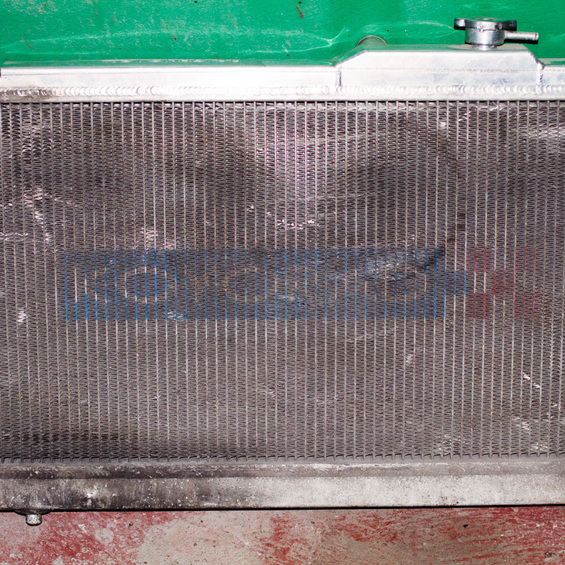
Radiator is one of the most important elements in the car cooling system. Due to the design and location, this detail requires systematic care. The uncleaned radiator can cause the engine to overheat and may end with expensive repairs in time.

It starts with a checkup.
The inspection of the heat sink does not present any particular difficulty for the car owner. It is enough every time you open the hood, for example, to get water in a tank of an omizer, inspect this easily accessible element. Even a cursory glance at a man who is not too familiar with cars is enough to understand the extent to which the radiator's ordeal is hard.
Good protection of the outer surface of the radiator is a small steel net that can be purchased in any auto shop
It is harder to determine the malfunctioning of the heat sink that is hidden from the visual inspection, namely the presence of dirt on the inner surfaces. However, there is an easy way to determine this problem. The net inside the heat sink is evenly warm over the entire area. If one of the plots is filled, it can be determined by touch. Remember what to do when the engine is only warm, but the liquid has already started to circulate in a large circle. Felling the radiator after a long trip can end with burns.
Heat sink protection
The good protection of the outer surface of the radiator from the flying dirt, insects and tepolus is the installation of a small grid in front of the radiator. The grid, hidden behind the bumper, does not spoil the appearance of the car and reliably protects the surface of the radiator from the penetration of foreign objects. You can install a safety net in almost any auto-hang.
Purging the heat sink
The external dirt accumulated between the hundredth of the radiator prevents it from cooling, leads to an increase in engine coolant temperature and engine overheating.
The heat sink under pressure is better from a distance of at least 15 to 20 centimeters. It is highly desirable to reduce the pressure of water to a minimum
In order to clean the radiator, various methods are used, one of which is pressure washing with Kercher-type equipment. This is a very efficient way, but it requires caution, because when the water is too high, the water hundredths of the radiator can be bent. It was not uncommon for the old radiators to have been destroyed, and more than that, sometimes even a pipe was thrown away. Therefore, we want to use the radiator, preferably with extreme caution, not to bring the kerher to the top of the radiator and to the minimum pressure.
To wash the radiator and the entire cooling system, special trains shall be made that fill or sleep on the operating system before the trip. They should be used with great care
The most efficient and "shedding" method of washing the heat sink is the closing of the dismantled part in the bath with the cleaning solution. As a rule, the radiator is rinmed not only from the outside, but also from the inside to avoid removing the radiator twice.

How to determine the contamination of the inner surface?
The indicator that the heat sink needs to be washed is the dirty coolant. Flushing will not prevent the replacement of cooling fluid. However, too much too hard: if the cooler is replaced with a coolant and no impurities, you can be assured of its purity. In addition, modern cooling fluids are composed of anticorrosive additives, which form a solid protective film inside the refrigeration system, which can be damaged during an intensive washing process. Rust, along with motor oil hit with serious engine breakage, two main causes of contamination of the inside surface of the radiator.
Method of washing the inside of the radiator by its forces
When internal contamination of the radiator is detected, it needs to be washed with the use of special trains. It is necessary to leak the coolant. If it has recently changed and has not lost its properties, then it can be flooded for further use.
Water is then poured into the system, preferably distilled, devoting different impurities, and a tool for washing the cooling system is added. Starting the engine-and the system shall be independently washed during the time period specified in the annotation to the swilling-out tool. Then the water flowed and flowed clean, without any additives. The system is washed away with clean water several times while it is controlled (by touch) the area of the radiator that was supposedly filled with dirt.
Hazardous flushing
It is highly unadvisable to use the calist soda or the "Antiquicepipe" composition when the cooling system is flushing, as the remaining residue is eating out the inner surface, and such flushing will end with the purchase of the new heat sink.
Before [ [ World War II]], we did not need to take the car radiator-the system used pure pure water
If the engine is over-heated after washing the system, the radiator is still not fully radiated and must be given in a specialized workshop for full solration and mechanical cleaning or be replaced.
Do you need to clean the radiators?
The cleaning is mainly for copper and brass radiators, as aluminum radiators with plastic batchs are considered not to be recycled.
Their disassembly is a painstaking process, because because of the physical properties of the aluminum petals of the radiator, the petals fail to bend more than once.







